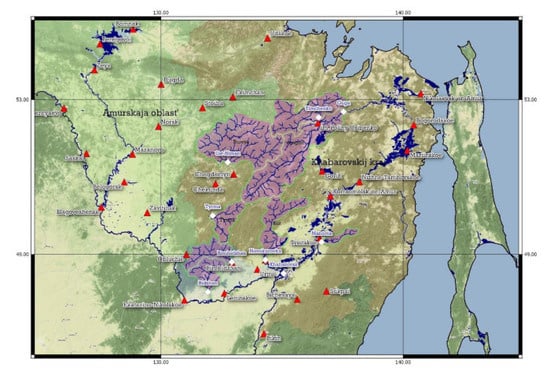Impact of Deforestation on Streamflow in the Amur River Basin
Abstract
1. Introduction
- According to meteorological observations, to analyze the temperature and precipitation;
- To analyze and evaluate streamflow indicators and water levels in the watersheds;
- Using remote sensing to analyze and estimate the variability of coniferous and broadleaf forest areas on watersheds.
2. Materials and Methods
2.1. Study Area
2.2. Hydrological Indicators
2.3. Climatic Indicators
2.4. Precipitation
2.5. Estimation of Watersheds Forest Coverage
3. Results
3.1. Increasing Indicators of Streamflow
3.2. Stable Trend Decreasing Percentage of Coniferous Forests
4. Discussion
- Annual data about forest coverage and new fumes after forest fires and felling;
- Forest coverage data in a watershed basin;
- Forests areas separate measurements for species composition.
5. Conclusions
Author Contributions
Acknowledgments
Conflicts of Interest
Appendix A
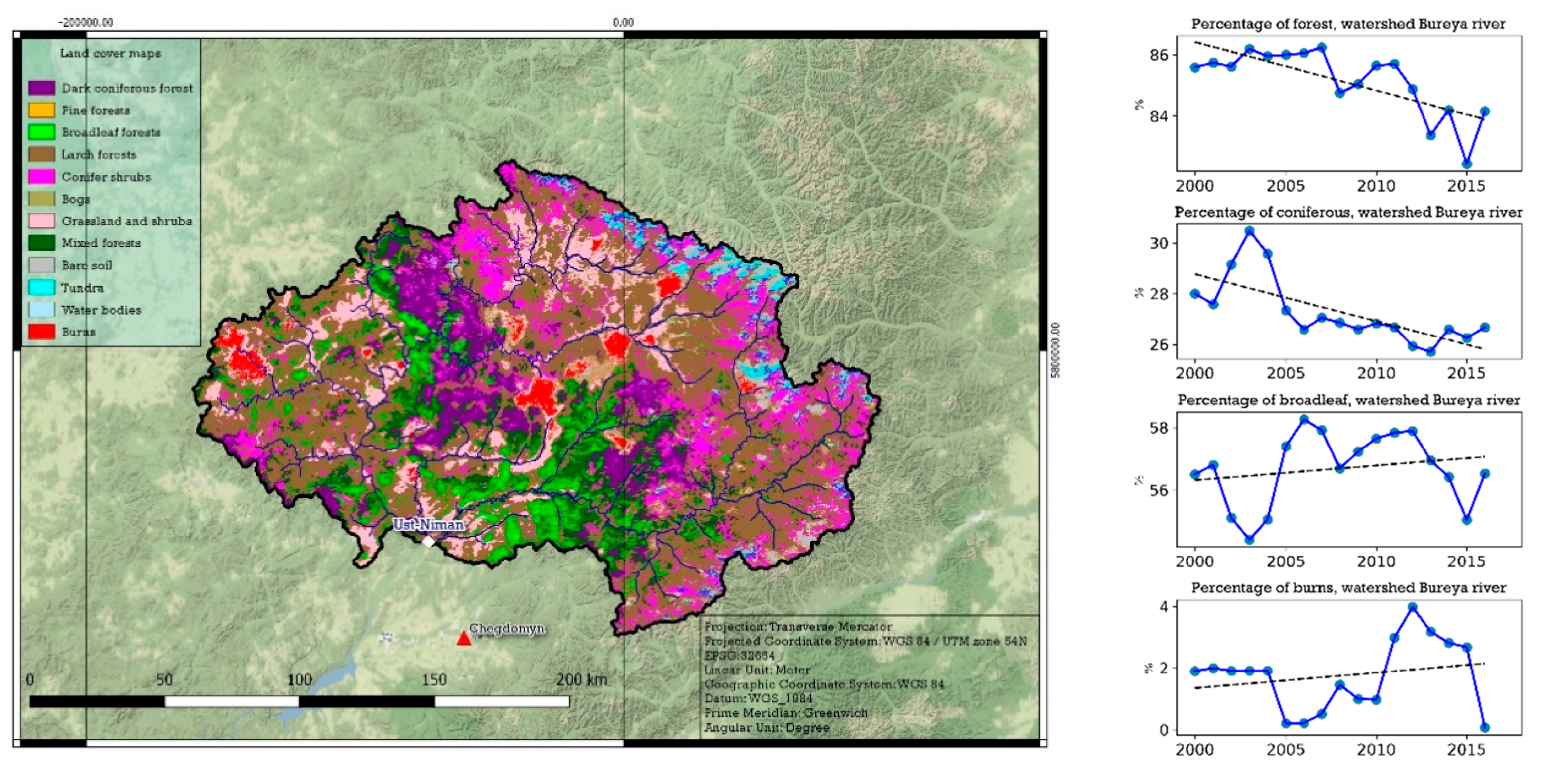
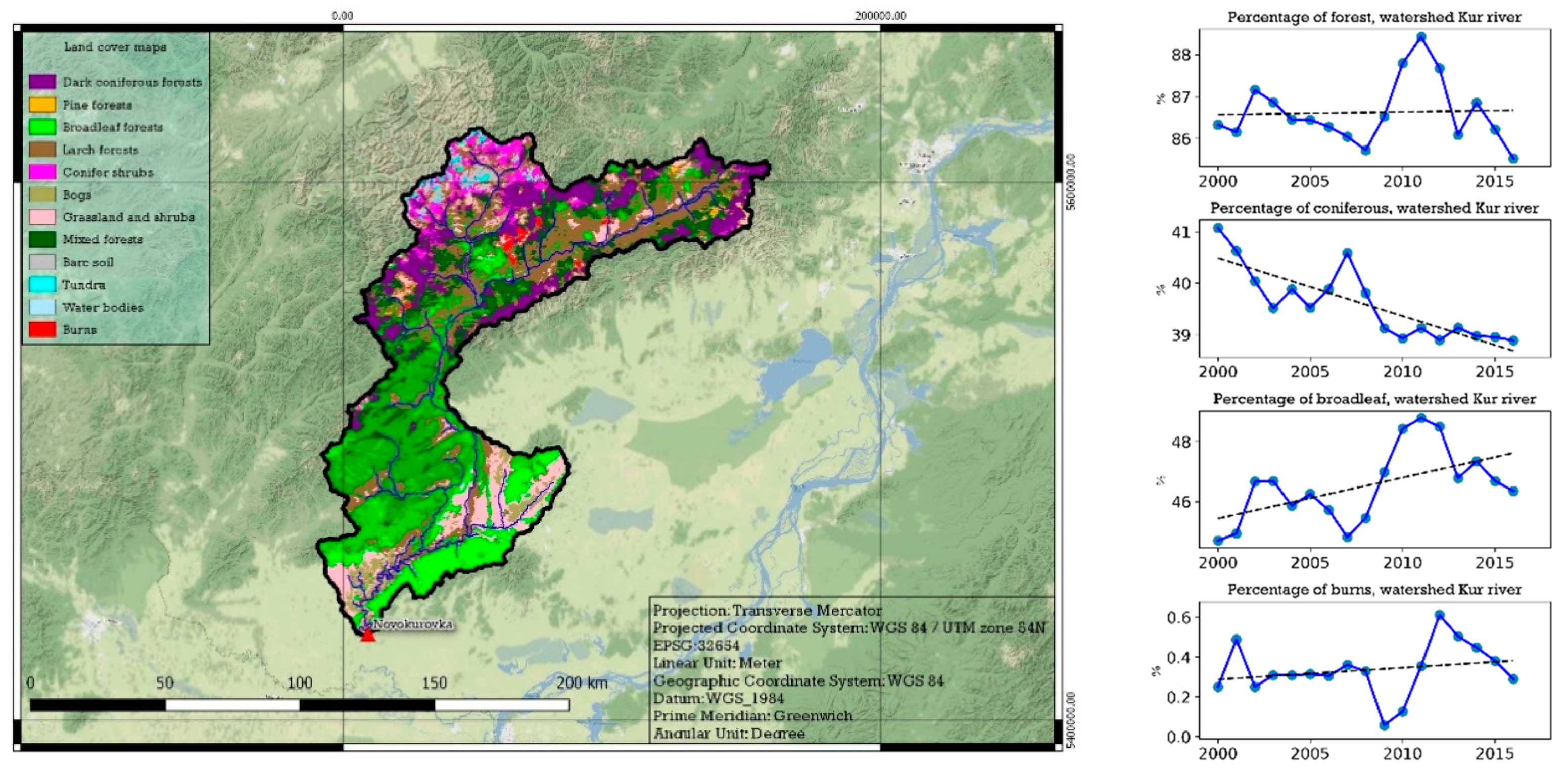

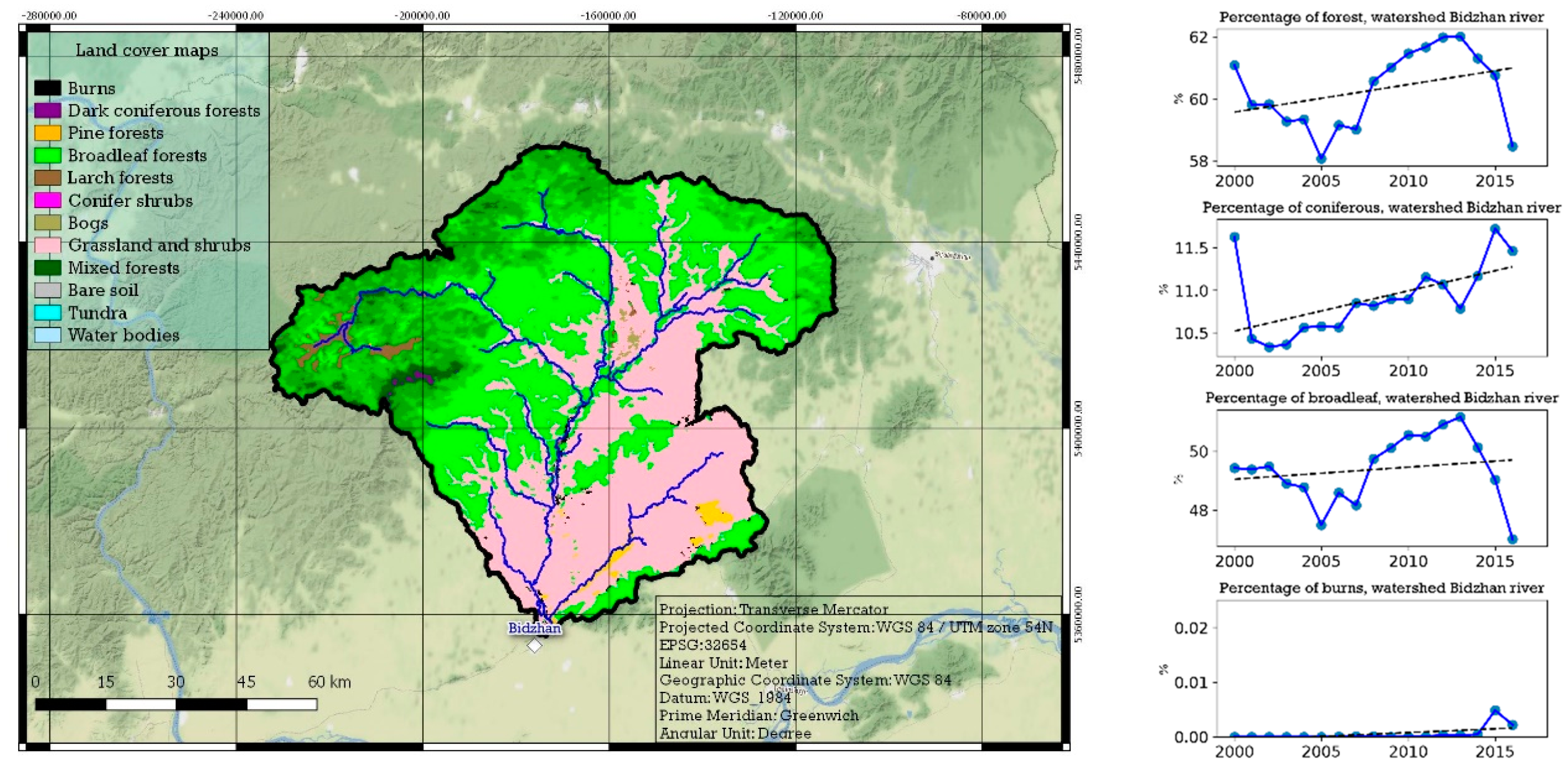
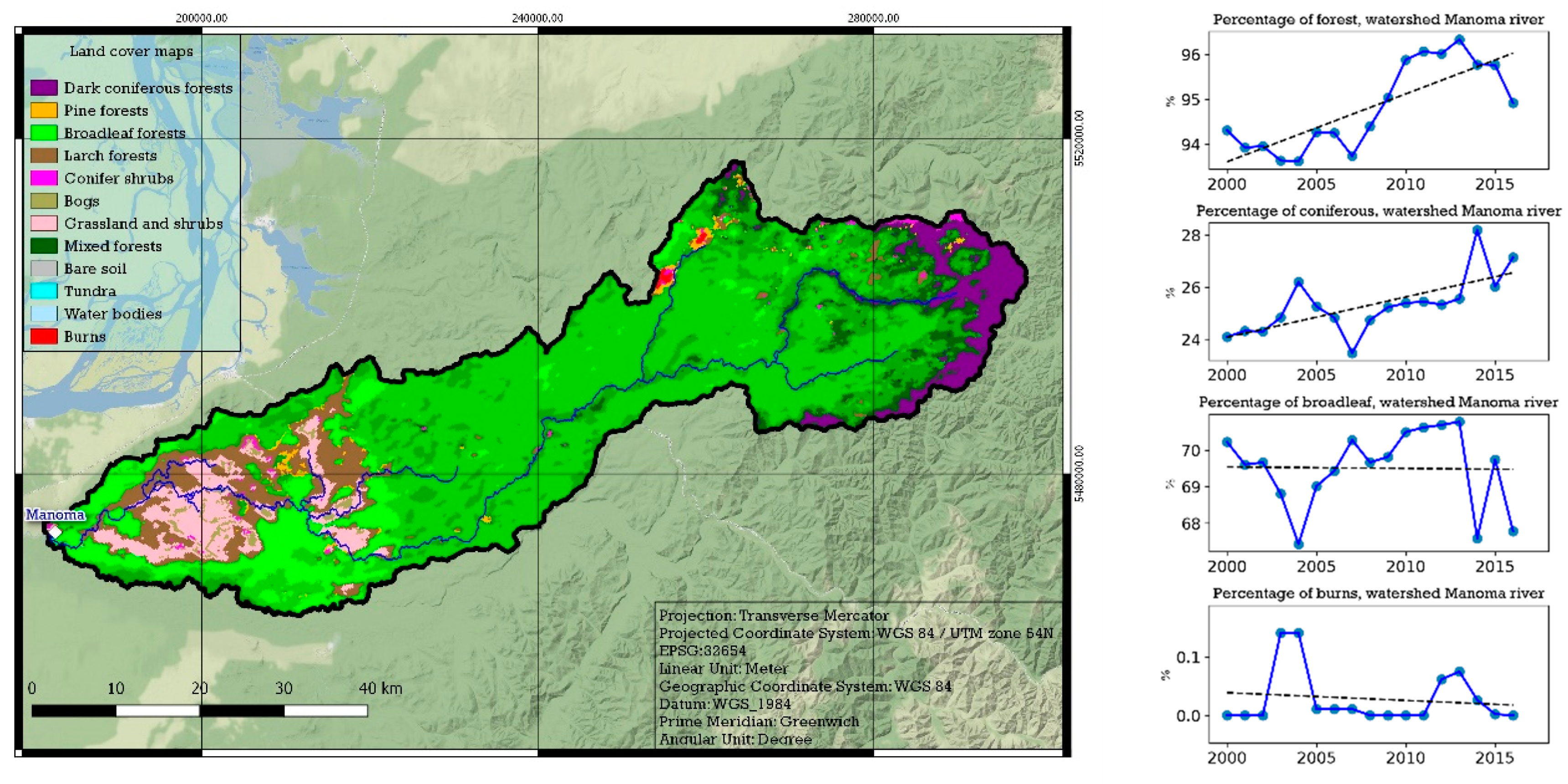
References
- Giambelluca, T.W.; Nullet, M.A.; Ziegler, A.D.; Tran, L. Latent and sensible energy flux over deforested land surfaces in the eastern Amazon and northern Thailand. Singap. J. Trop. Geogr. 2000, 21, 107–130. [Google Scholar] [CrossRef]
- Bonell, M. Possible impacts of climate variability and change on tropical forest hydrology. Clim. Chang. 1998, 39, 215–272. [Google Scholar] [CrossRef]
- Bosch, J.M.; Hewlett, J.D. A review of catchment experiments to determine the effect of vegetation changes on water yield and evapo-transpiration. J. Hydrol. 1982, 55, 3–23. [Google Scholar] [CrossRef]
- Brown, A.; Zhang, L.; McMahon, T.; Western, A.; Vertessy, R. A review of paired catchment studies with reference to the seasonal flows and climate variability. J. Hydrol. 2005, 310, 28–61. [Google Scholar] [CrossRef]
- Espejo, J.C.; Messinger, M.; Román-Dañobeytia, F.; Ascorra, C.; Fernandez, L.E.; Silman, M. Deforestation and Forest Degradation Due to Gold Mining in the Peruvian Amazon: A 34-Year Perspective. Remote Sens. 2018, 10, 1903. [Google Scholar]
- Jones, J.A.; Post, D.A. Seasonal and successional streamflow response to forest cutting and regrowth in the Northwest and Eastern United States. Water Resour. Res. 2004, 40. [Google Scholar] [CrossRef]
- Krestovskiy, O.I. Impact of Deforestation and Forest Restoration on River Water; Gidrometeorologicheskoe izd.: Leningrad, Russia, 1983; 117p. [Google Scholar]
- Maina, J.; De Moel, H.; Zinke, J.; Madin, J.; McClanahan, T.; Vermaat, J.E. Human deforestation outweighs future climate change impacts of sedimentation on coral reefs. Nature Communications. Nat. Commun. 2013, 4, 1986. [Google Scholar] [CrossRef]
- Swank, W.T.; Swift, L.W., Jr.; Douglas, J.E. Streamflow changes associated with forest cutting species conversions and natural disturbances. In Forest Hydrology and Ecology at Coweeta; Springer: New York, NY, USA, 1988; pp. 297–312. [Google Scholar]
- Klinzov, A.P. The Protective Role of Sakhalin Forests; Far Eastern Forestry Research Institute: Khabarovsk, Russia, 1973; 233p. [Google Scholar]
- Costa, M.H.; Botta, A.; Cardille, J.A. Effects of large-scale changes in land cover on the discharge of the Tocantins River, Southeastern Amazonia. J. Hydrol. 2003, 283, 206–217. [Google Scholar] [CrossRef]
- Matheussen, B.; Kirschbaum, R.L.; Goodman, I.A.; O’Donnell, G.M.; Lettenmaier, D.P. Effects of land cover change on streamflow in the interior Columbia River Catchment (USA and Canada). Hydrol. Process. 2000, 14, 867–885. [Google Scholar] [CrossRef]
- Siriwardena, L.; Finlayson, B.L.; McMahon, T.A. The impacts of land use change on catchment hydrology in large catchments: The Comet River, Central Queensland, Australia. J. Hydrol. 2006, 326, 199–214. [Google Scholar] [CrossRef]
- Zhang, Y.; Guan, D.; Jin, C.; Wang, A.; Wu, J.; Yuan, F. Impacts of climate change and land use change on runoff of forest catchment in northeast China. Hydrol. Process. 2014, 28, 186–196. [Google Scholar] [CrossRef]
- Kolesnikov, B.P. Forest areas of the taiga zone of the USSR and the forestry system in the aspect of long-term forecasts. In Informational Bulletin of the Scientific Council on the Integrated Development of Taiga Territories; Siberian Institute of Geography: Irkutsk, Russia, 1969; pp. 9–40. [Google Scholar]
- Danilin, A.K. Forest management of the Far East; Publishing Group “Our time”: Khabarovsk, Russia, 2009; 335p. [Google Scholar]
- Resources of Surface Waters of the USSR. Vol. 18. Far East. Issue 1. Upper and Middle Amur River; Gidrometeorologicheskoe izd.: Leningrad, Russia, 1966; 781p.
- Resources of Surface Waters of the USSR. Vol. 18. Far East. Issue 2. Lower Amur River; Gidrometeorologicheskoe izd.: Leningrad, Russia, 1970; 592p.
- Solov’ev, K.P. Cedar-Deciduous Forests of the Far East and the Management in Them; Khabarovsk Book Publishing: Khabarovsk, Russia, 1958; 367p. [Google Scholar]
- Shirokova, M.R. Dependence of the monsoon climate river runoff on physiographic factors in the Lower Amur region. In Formation of Natural Waters of the Far East; Far Eastern Scientific Centre: Vladivostok, Russia, 1983; pp. 43–55. [Google Scholar]
- Opritova, R.V. Elevated Phytomass of Forests and River Runoff in the South Sikhote-Alin; Far Eastern Branch: Vladivostok, Russia, 1991; 781p. [Google Scholar]
- Bartalev, S.A.; Egorov, V.A.; Loupian, E.A.; Khvostikov, S.A. A new locally-adaptive classification method LAGMA for large-scale land cover mapping using remote-sensing data. Remote Sens. Lett. 2014, 5, 55–64. [Google Scholar] [CrossRef]
- Hansen, M.C.; Potapov, P.V.; Moore, R.; Hancher, M.; Turubanova, S.A.; Tyukavina, A.; Thau, D.; Stehman, S.V.; Goetz, S.J.; Loveland, T.R.; et al. High-resolution global maps of 21st-century forest cover change. Science 2013, 342, 850–853. [Google Scholar] [CrossRef] [PubMed]
- Kennedy, R.E.; Yang, Z.; Cohen, W.B. Detecting trends in forest disturbance and recovery using yearly Landsat time series: 1. LandTrendr—Temporal segmentation algorithms. Remote Sens. Environ. 2010, 114, 2897–2910. [Google Scholar] [CrossRef]
- Zhou, S.; Zhang, W. Calibration and validation of a semi-distributed hydrological model in the Amur River Basin using remote sensing data. Remote Sens. Agric. Ecosyst. Hydrol. XIX 2017, 10421, 1042104. [Google Scholar]
- Tachibana, Y.; Oshima, K.; Ogi, M. Seasonal and interannual variations of Amur River discharge and their relationships to large-scale atmospheric patterns and moisture fluxes. J. Geophys. Res. Atmos. 2008, 113, D16102. [Google Scholar] [CrossRef]
- Torzhkov, I.O.; Kushnir, E.A.; Konstantinov, A.V.; Koroleva, T.S.; Efimov, S.V.; Shkolnik, I.M. Assessment of future climate change impacts on forestry in Russia. Russ. Meteorol. Hydrol. 2019, 44, 180–186. [Google Scholar] [CrossRef]
- Frolov, A.V.; Georgievskii, Y.V. Changes in Water Resources under Conditions of Climate Warming and Their Impact on Water Inflow to Russian Large Reservoirs. Russ. Meteorol. Hydrol. 2018, 43, 390–396. [Google Scholar] [CrossRef]
- Sokolova, G.V.; Makogonov, S.V. Development of the forest fire forecast method (a Case Study for the Far East). Russ. Meteorol. Hydrol. 2013, 38, 222–226. [Google Scholar] [CrossRef]
- Sokolova, G.V. Analyzing the Amur River water regime for the period preceding the catastrophic flood in 2013. Russ. Meteorol. Hydrol. 2015, 7, 66–69. [Google Scholar] [CrossRef]
- Sokolova, G.V.; Teteryatnikova, E.P. The Problem of Long-Term Forecast of Fire Risk in the Forest of the Khabarovsk Territory and Jewish Autonomous Region according to Meteorological Conditions; Sokolova, G., Teteryatnikova, E., Eds.; Russian Academy of Sciences, Far Eastern Branch, Institute of Water and Ecological Problems: Khabarovsk, Russia, 2008; 150p. [Google Scholar]
- Heim, W.; Sokolova, G.V.; Trense, D.; Kitagawa, T. Increased populations of endangered cranes after Amur River flood. Waterbirds. 2017, 40, 282–288. [Google Scholar] [CrossRef]
- Semenov, E.K.; Sokolikhina, N.N.; Tatarinovich, E.V. Monsoon circulation over the Amur River basin during catastrophic flood and extreme drought in summer. Russ. Meteorol. Hydrol. 2017, 42, 141–149. [Google Scholar] [CrossRef]
- Bartalev, S.A.; Egorov, V.A.; Ershov, D.V.; Isaev, A.S.; Loupian, E.A.; Plotnikov, D.E.; Uvarov, I.A. Mapping of Russia’s vegetation cover using MODIS satellite spectroradiometer data. Sovrem. Probl. Distantsionnogo Zondirovaniya Zemli Kosmosa 2011, 8, 285–302. [Google Scholar]
- Hermosilla, T.; Wulder, M.A.; White, J.C.; Coops, N.C.; Hobart, G.W. Regional detection, characterization, and attribution of annual forest change from 1984 to 2012 using Landsat-derived time-series metrics. Remote Sens. Environ. 2015, 170, 121–132. [Google Scholar] [CrossRef]
- Lichtenthaler, H.K. Vegetation Stress: An Introduction to the Stress Concept in Plants. J. Plant Physiol. 1996, 148, 4–14. [Google Scholar] [CrossRef]
- Google’s Earth Engine. Available online: https://earthengine.google.com/ (accessed on 8 June 2019).
- Zurqani, H.A.; Christopher, J.P.; Mikhailova, E.A.; Schlautman, M.A.; Sharp, J.L. Geospatial analysis of land use change in the Savannah River Basin using Google Earth Engine. Int. J. Appl. Earth Obs. Geoinf. 2018, 69, 175–185. [Google Scholar] [CrossRef]
- Egorov, V.A.; Bartalev, S.A.; Kolbudaev, P.A.; Plotnikov, D.E.; Khvostikov, S.A. Land cover map of Russia derived from Proba-V satellite data. Sovrem. Probl. Distantsionnogo Zondirovaniya Zemli Kosmosa 2018, 15, 282–286. [Google Scholar] [CrossRef]
- Torres, R.; Snoeij, P.; Geudtner, D.; Bibby, D.; Davidson, M.; Attema, E.; Potin, P.; Rommen, B.; Floury, N.; Brown, M.; et al. GMES Sentinel-1 mission. Remote Sens. Environ. 2012, 120, 9–24. [Google Scholar] [CrossRef]
- Choker, M.; Baghdadi, N.; Zribi, M.; Hajj, M.E.; Paloscia, S.; Verhoest, N.E.C.; Lievens, H.; Mattia, F. Evaluation of the Oh, Dubois and IEM Backscatter Models Using a Large Dataset of SAR Data and Experimental Soil Measurements. Water 2017, 9, 38. [Google Scholar] [CrossRef]
- Gao, Q.; Zribi, M.; Escorihuela, M.J.; Baghdadi, N. Synergetic Use of Sentinel-1 and Sentinel-2 Data for Soil Moisture Mapping at 100 m Resolution. Sensors 2017, 17, 1966. [Google Scholar] [CrossRef]
- Merzouki, A.; McNairn, H.; Pacheco, A. Mapping Soil Moisture Using RADARSAT-2 Data and Local Autocorrelation Statistics. IEEE J. Sel. Top. Appl. Earth Obs. Remote Sens. 2011, 4, 128–137. [Google Scholar] [CrossRef]
- Van Doninck, J.; Peters, J.; Lievens, H.; De Baets, B.; Verhoest, N.E.C. Accounting for seasonality in a soil moisture change detection algorithm for ASAR Wide Swath time series. Hydrol. Earth Syst. Sci. 2012, 16, 773–786. [Google Scholar] [CrossRef]
- Spirina, A.G.; Polyanskaya, S.M. Absorption of gray forest soils of nutrients leached from mineral fertilizers. Russ. J. For. Sci. 1987, 3, 163–177. [Google Scholar]
- Verkhoturov, A.L.; Sokolova, G.V.; Bartalev, S.A.; Kramareva, L.S. Investigation of forest hydrological processes in watersheds of the Amur River basin according to satellite and hydrometeorological observations. Sovrem. Probl. Distantsionnogo Zondirovaniya Zemli Kosmosa 2018, 15, 142–154. [Google Scholar] [CrossRef]
- Sorokin, A.A.; Makogonov, S.V.; Korolev, S.P. The Information Infrastructure for Collective Scientific Work in the Far East of Russia. Sci. Tech. Inf. Process. 2017, 44, 302–304. [Google Scholar] [CrossRef]

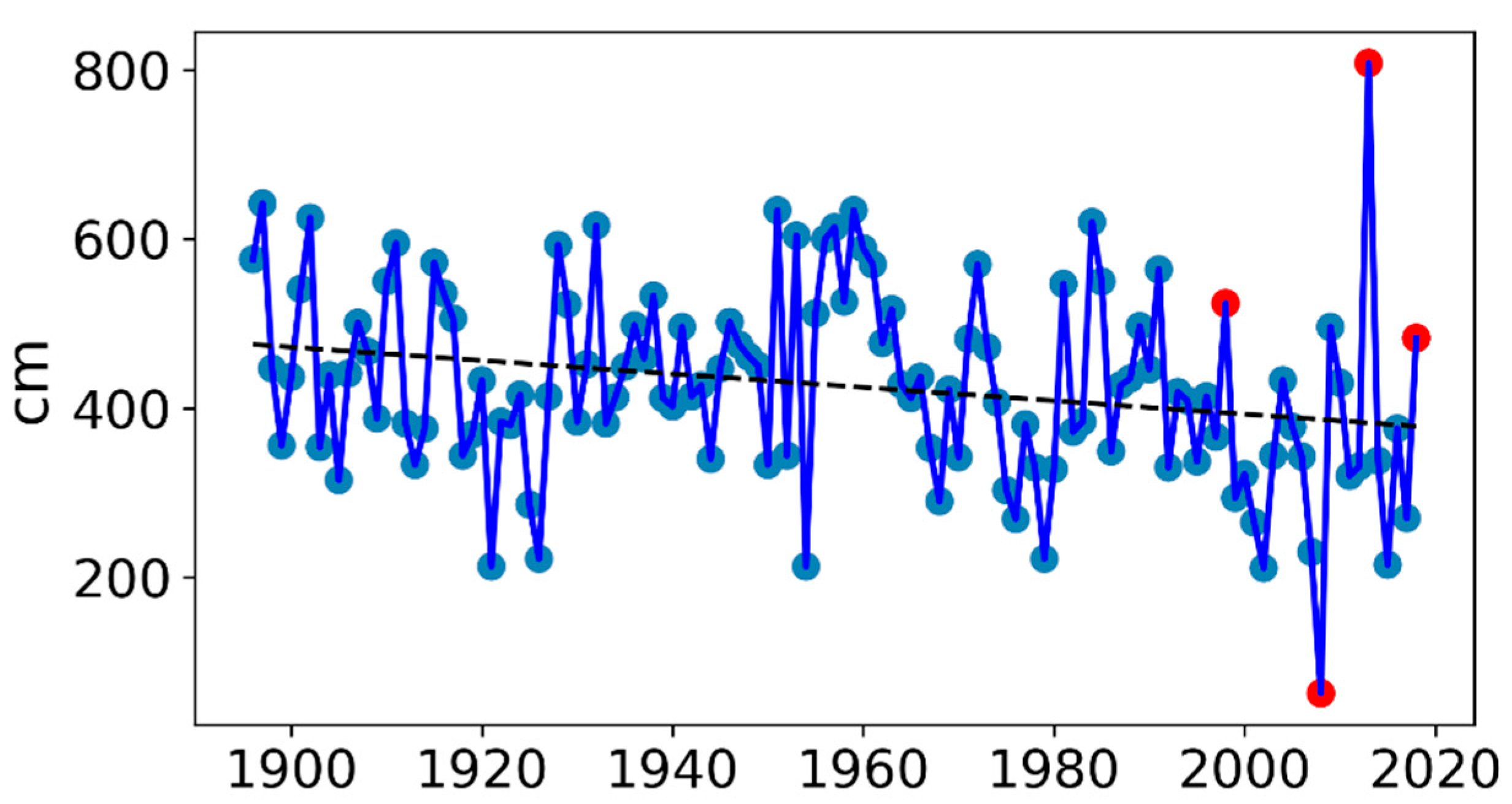
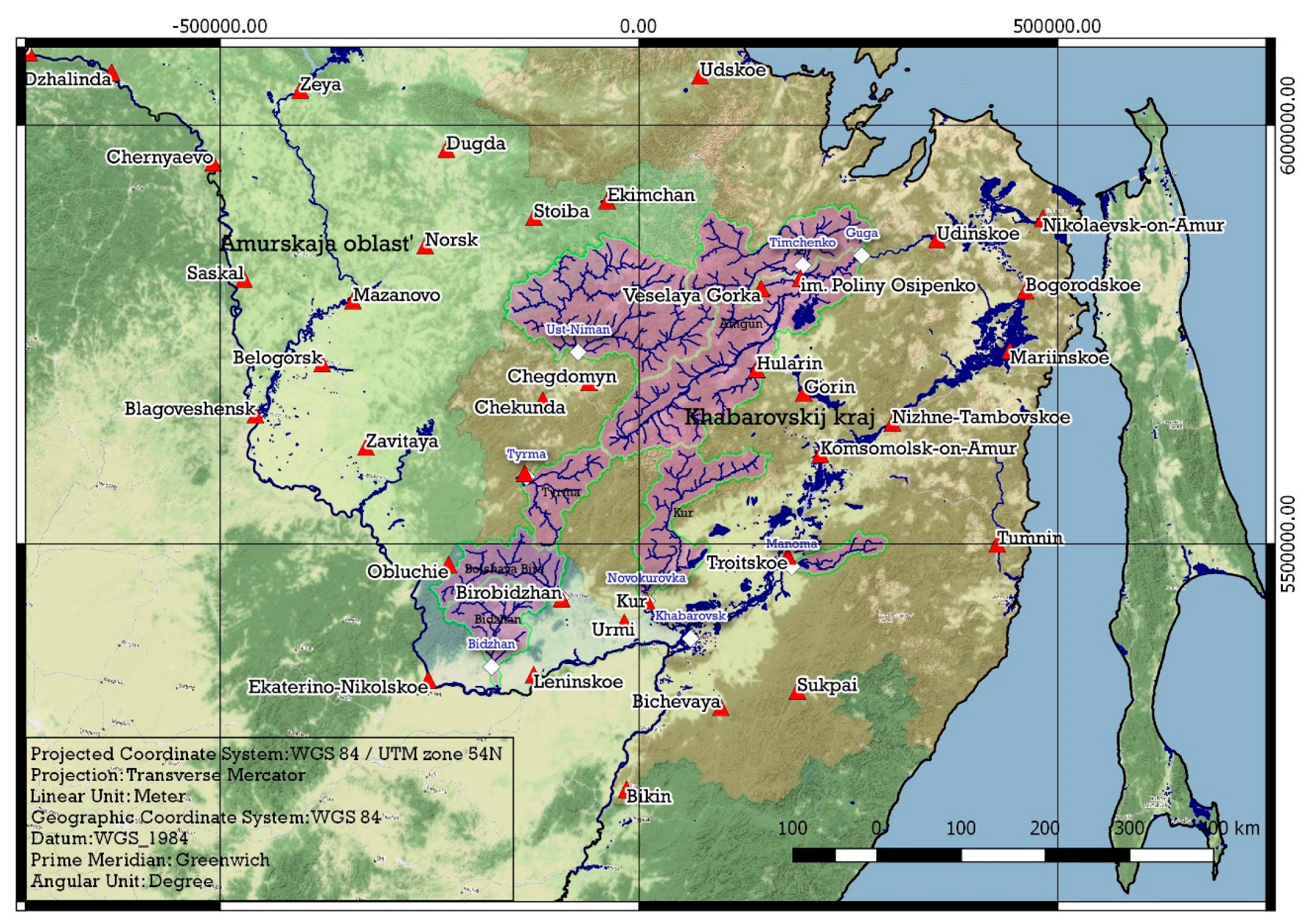
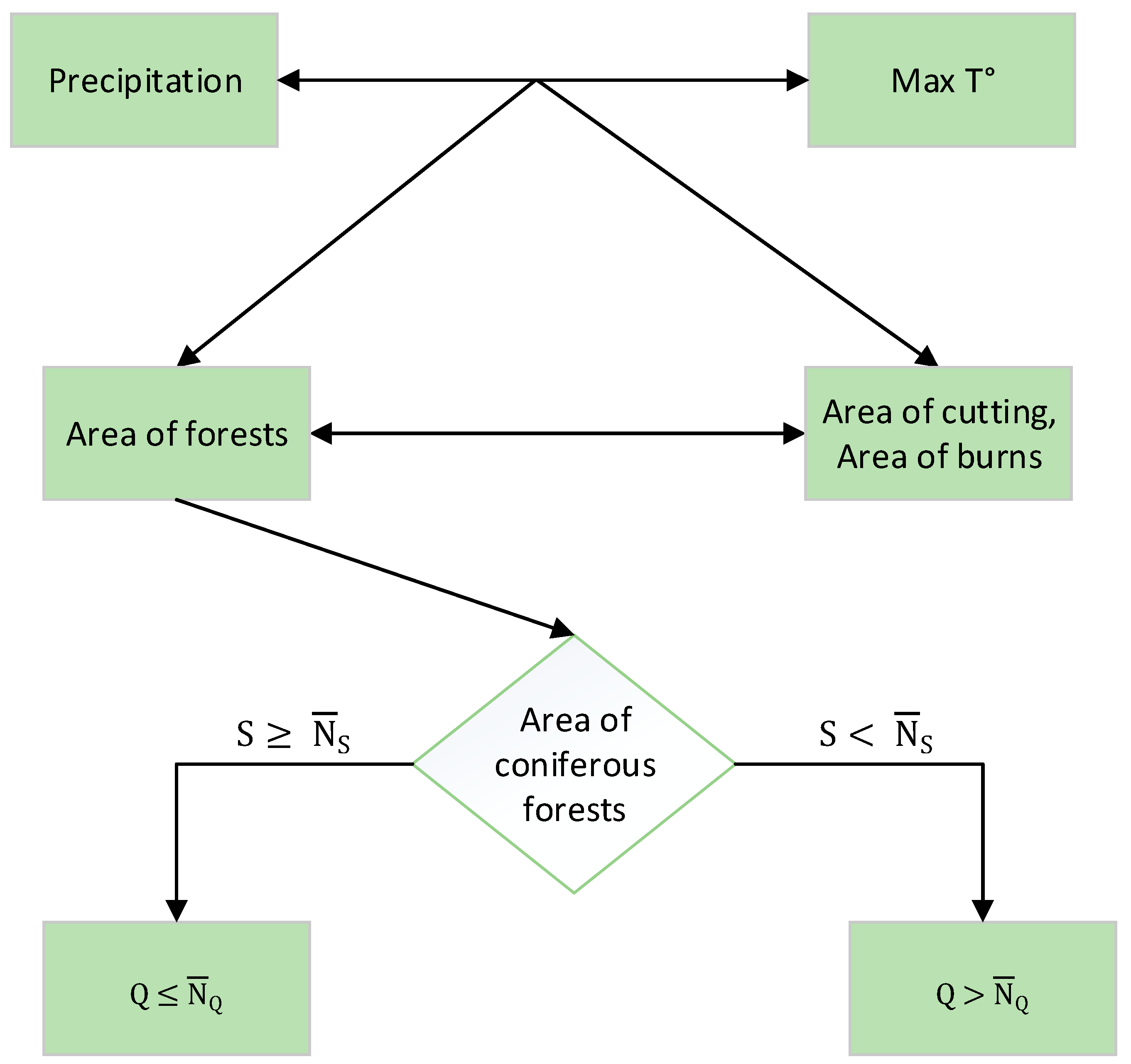
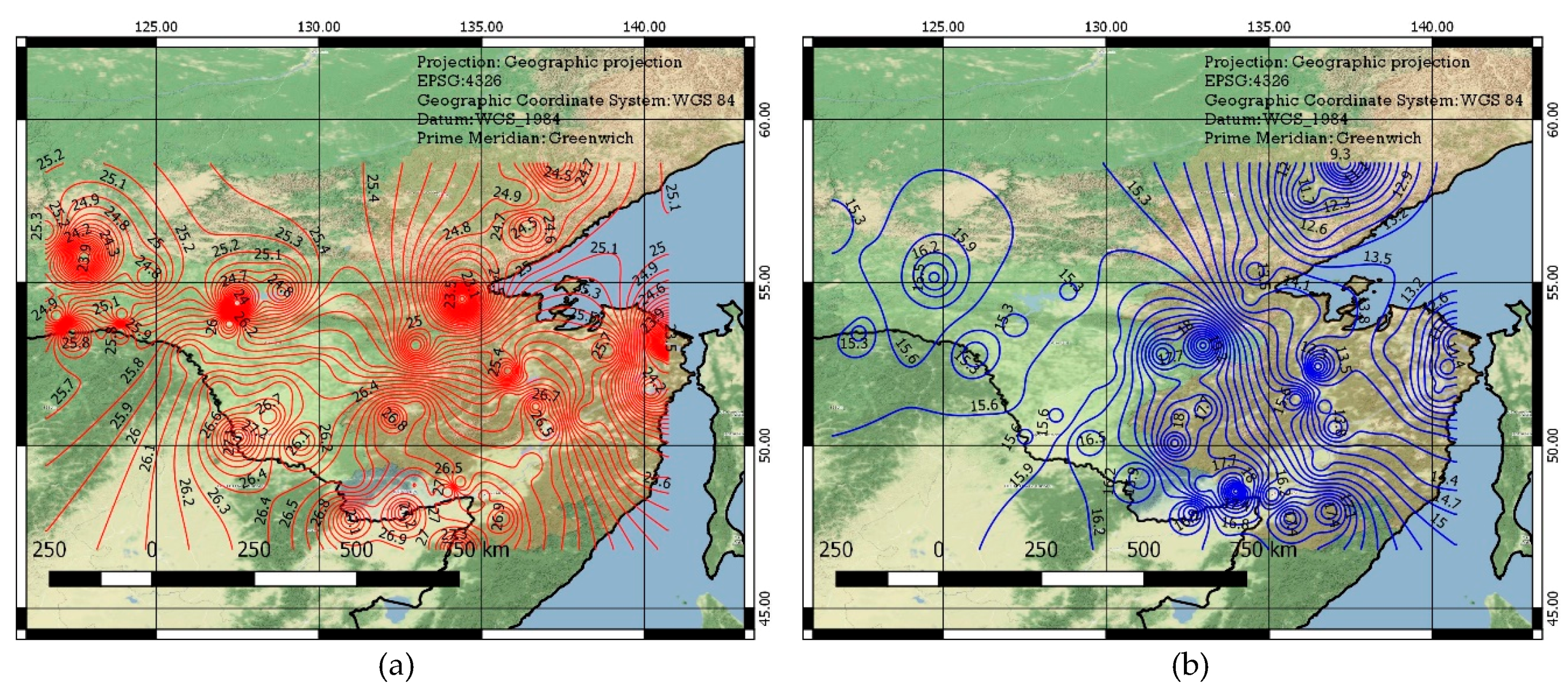
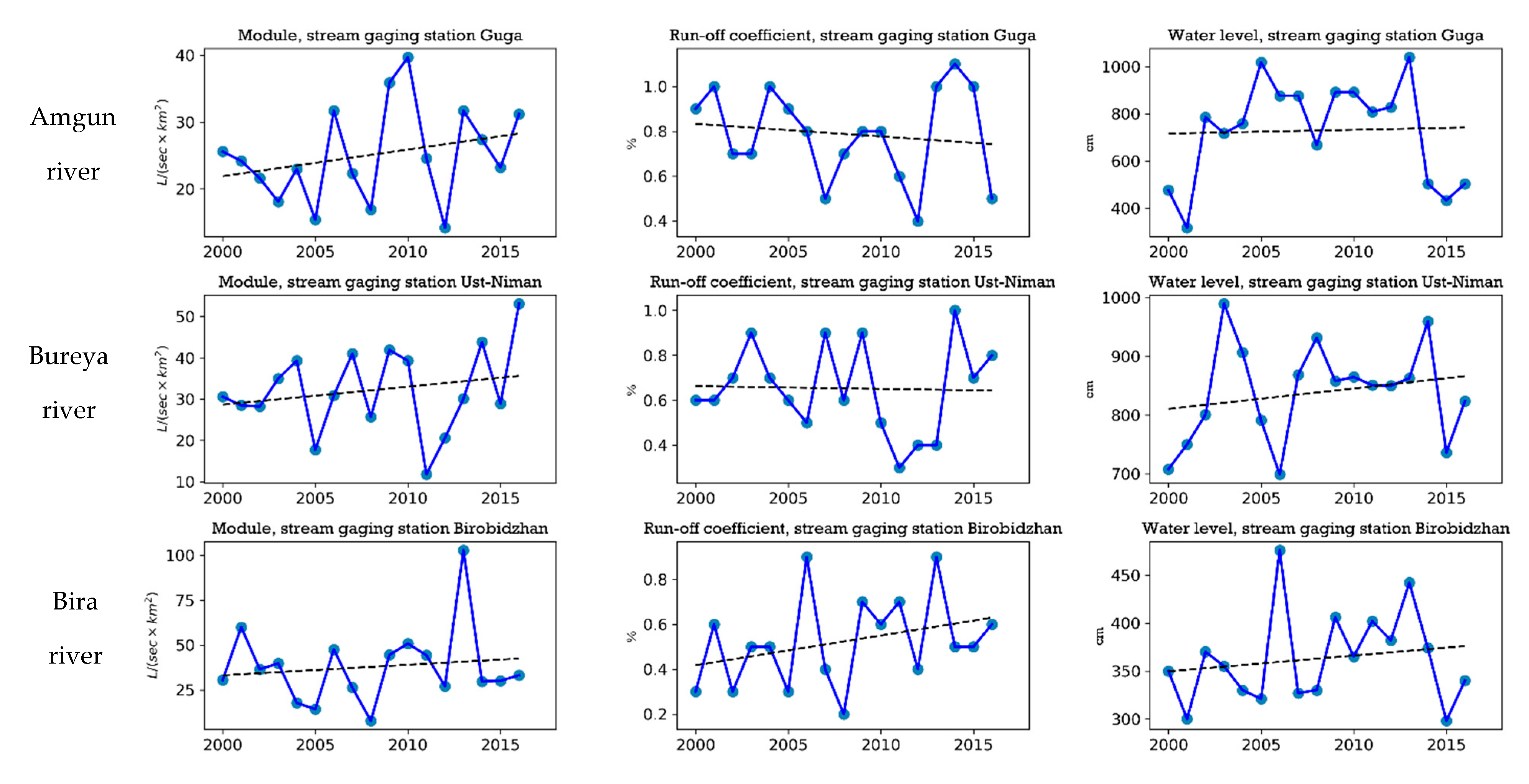
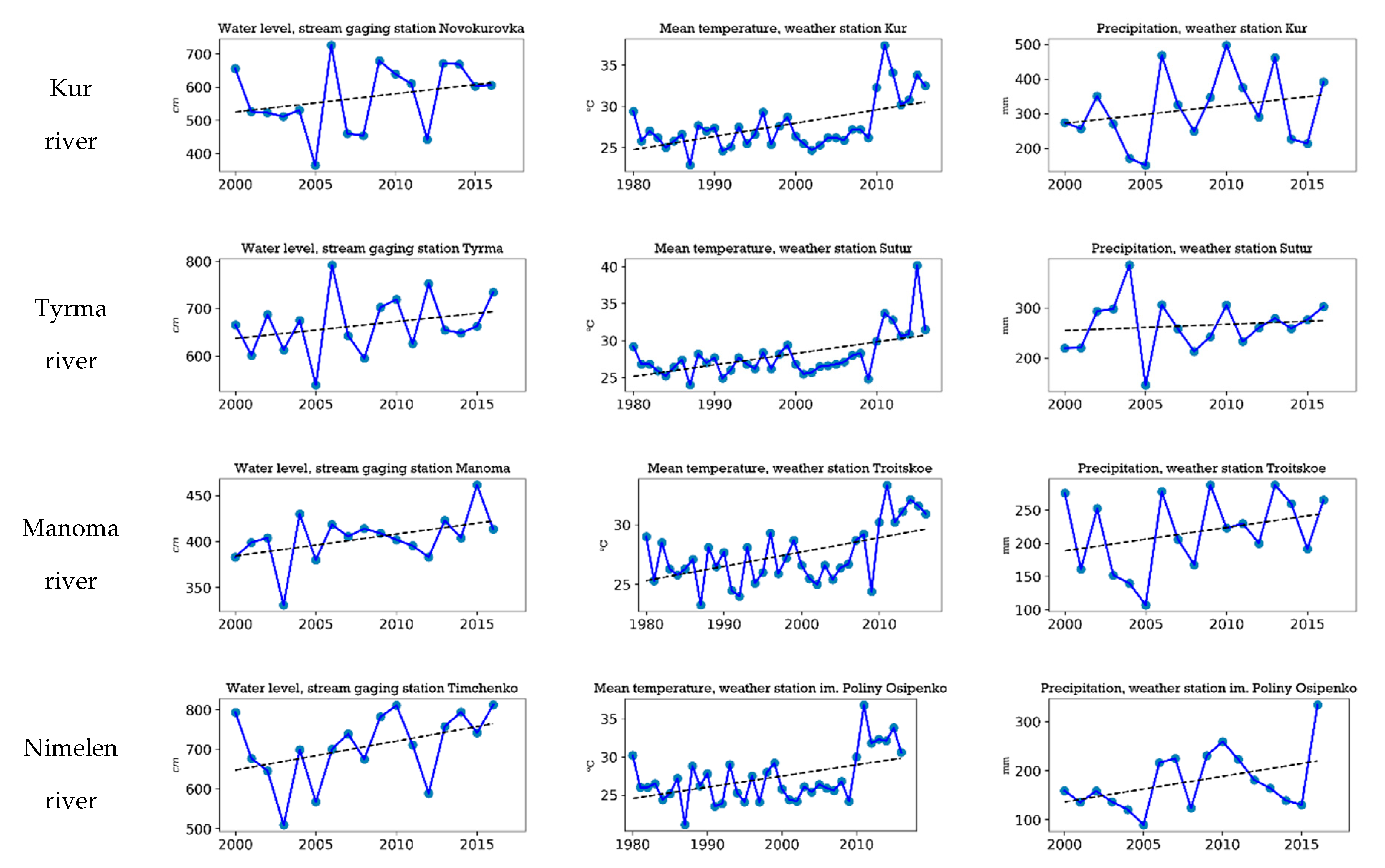

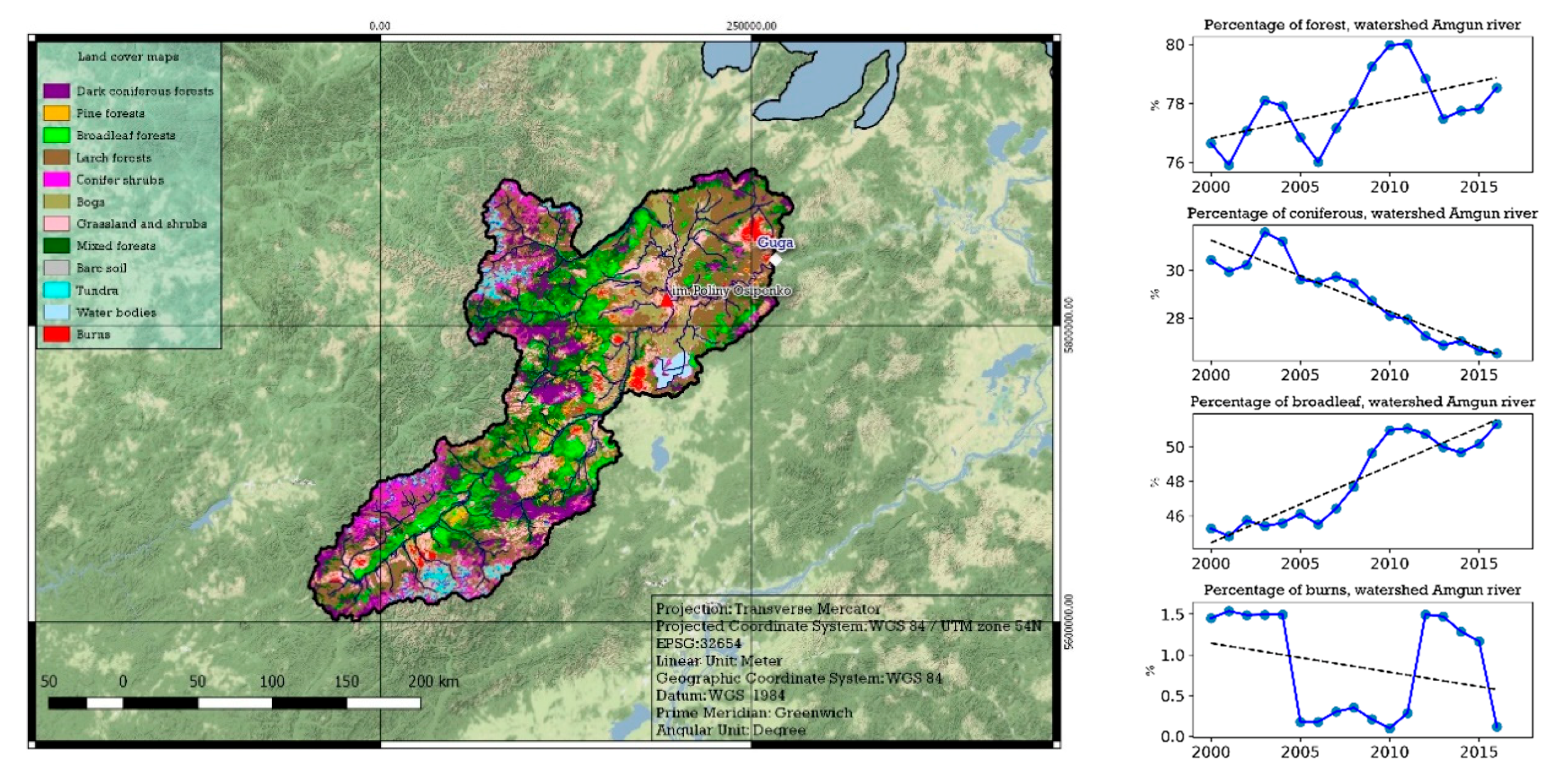
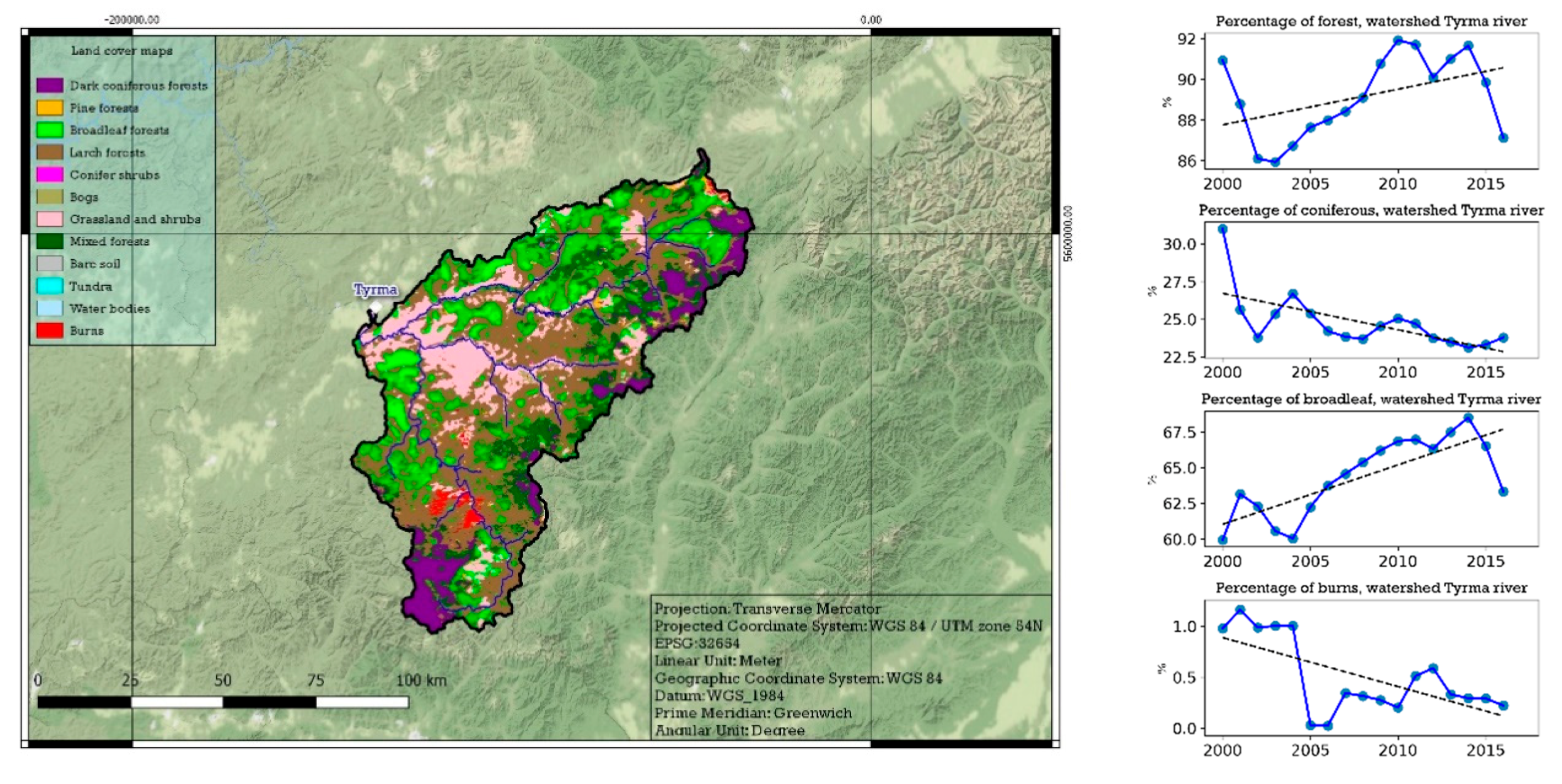
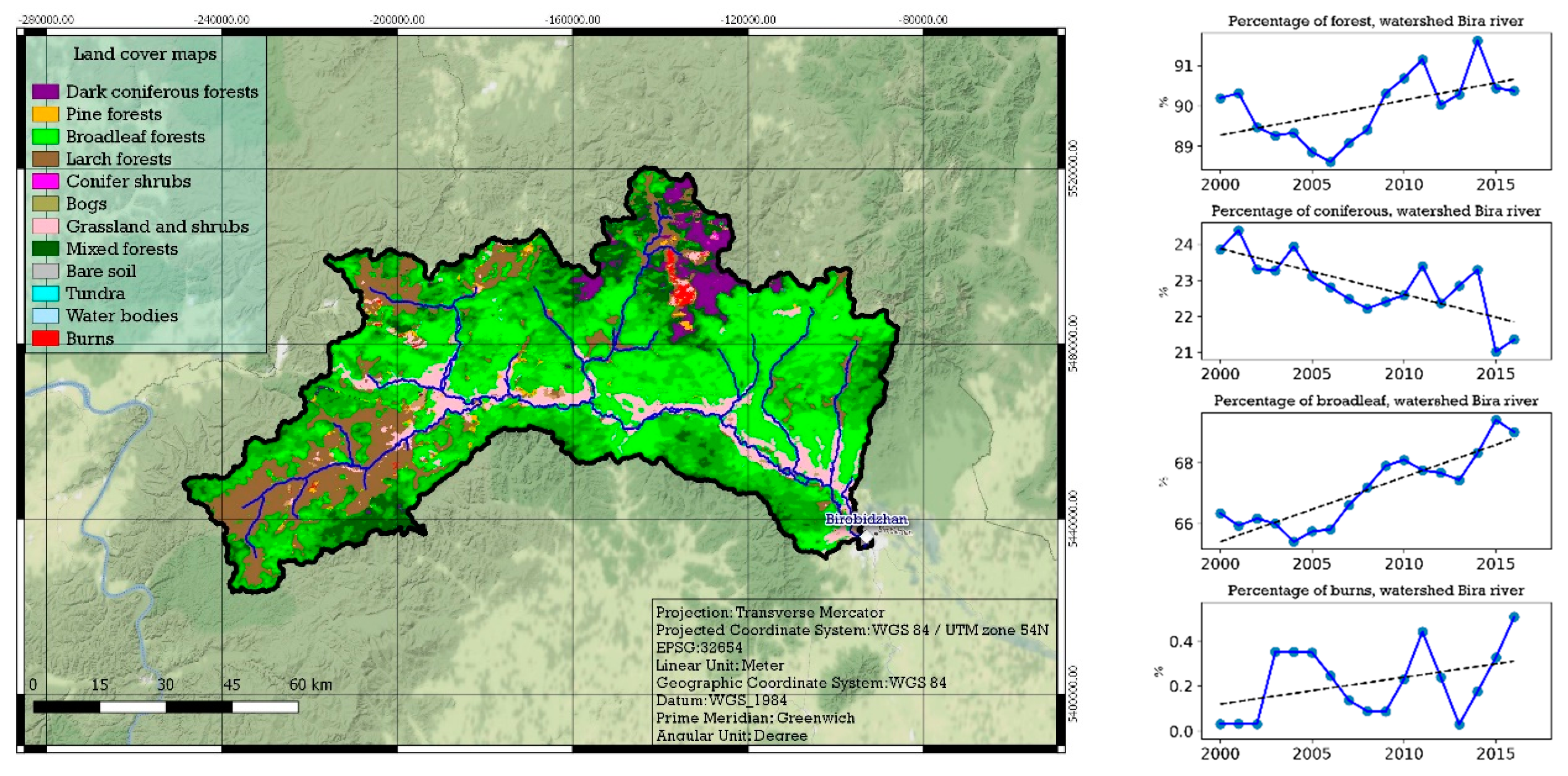
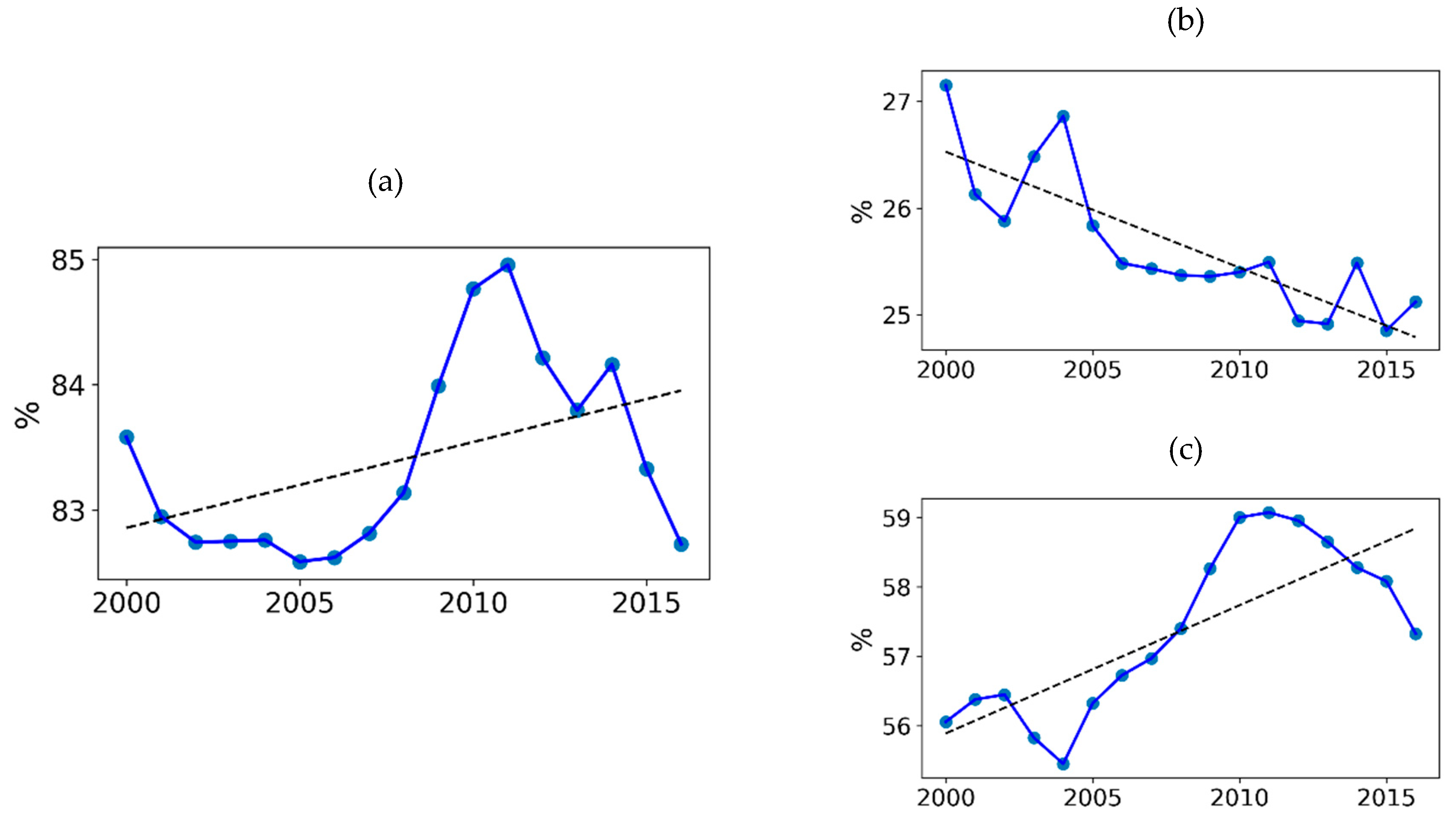
| Object | Data | Description |
|---|---|---|
| Basin of Amur | 1998 | Catastrophic forest fires and the 2 September Amur River floods reaching the height of 524 cm near Khabarovsk |
| Amur river | 2008 | 10–12 August catastrophic Summer-Autumn low water levels is an extreme low flood mark of 65 cm near Khabarovsk |
| Amur river | 2013 | 3–4 September catastrophic Amur River floods reaching the height of 808 cm near Khabarovsk |
| Shilka river | 2018 | 7 August catastrophic River Shilka floods (the left part of Amur River, caused the Amur River floods reaching the height of 483 cm near Khabarovsk |
| Name | Description |
|---|---|
| Volume of runoff, W (m3) | An amount of water passing in the river course through a given gauge over a set period of time (for example, annually) |
| Depth of runoff, Y (mm) | A layer of water evenly distributed over the area and flowing from a watershed over a period of time |
| Discharge, M (l/sec·km2) | Reflects the amount of flowing water (presented as average water discharge over a set period of time) from every square kilometre of a watershed over 1 s. |
| Runoff coefficient during the rainfall floods period (July–August), α (%) | The ratio of the depth of streamflow (mm) to the amount of atmospheric precipitation in the watershed area (mm) over the same period according to the local meteorological station |
| Water level over the zero mark on the gage, H (cm) | The maximum water levels over the period of rainfall floods (cm) |
| River | Stream Gauge | Area of Watershed (ha) | Percentage of Forest (%) | ||
|---|---|---|---|---|---|
| Amgun | settlement Guga | 41,000 * | 40636 | 71 * | 77.8 |
| Bidzhan | settlement Bidzhan | 7000 * | 7244 | 69 * | 60.3 |
| Bira | Birobidzhan | 7560 * | 7548 | 86 * | 90.1 |
| Bureya | settlement Ust-Niman | 26,500 * | 26,364 | 87 * | 85.2 |
| Kur | settlement Novokurovka | 11,600 * | 11,487 | 82 * | 86.6 |
| Manoma | settlement Manoma 1 | 2220 * | 2448 | 94 * | 94.8 |
| Nimelen | settlement Timchenko | 14,100 * | 13,882 | – | 75.0 |
| Tyrma | settlement Tyrma | 6550 * | 6561 | 83 * | 89.2 |
© 2019 by the authors. Licensee MDPI, Basel, Switzerland. This article is an open access article distributed under the terms and conditions of the Creative Commons Attribution (CC BY) license (http://creativecommons.org/licenses/by/4.0/).
Share and Cite
Sokolova, G.V.; Verkhoturov, A.L.; Korolev, S.P. Impact of Deforestation on Streamflow in the Amur River Basin. Geosciences 2019, 9, 262. https://doi.org/10.3390/geosciences9060262
Sokolova GV, Verkhoturov AL, Korolev SP. Impact of Deforestation on Streamflow in the Amur River Basin. Geosciences. 2019; 9(6):262. https://doi.org/10.3390/geosciences9060262
Chicago/Turabian StyleSokolova, Galina V., Andrei L. Verkhoturov, and Sergei P. Korolev. 2019. "Impact of Deforestation on Streamflow in the Amur River Basin" Geosciences 9, no. 6: 262. https://doi.org/10.3390/geosciences9060262
APA StyleSokolova, G. V., Verkhoturov, A. L., & Korolev, S. P. (2019). Impact of Deforestation on Streamflow in the Amur River Basin. Geosciences, 9(6), 262. https://doi.org/10.3390/geosciences9060262





